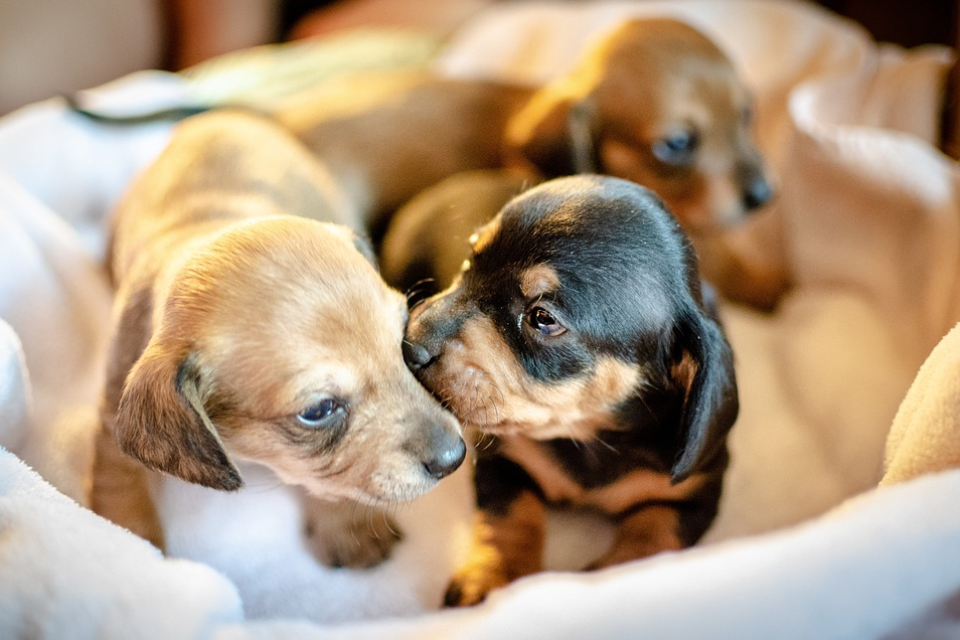As a mini dachshund owner, I know the joy of having a loving and loyal companion that has become a part of the family. One of the questions that often come up is whether or not a standard dachshund can be bred with a miniature dachshund. The answer is not as straightforward as one would think. In this blog post, we will delve into the differences between standard and miniature dachshunds, the health differences, and what it means to breed a dachshund.
Key Takeaways:
- Differences between standard and miniature dachshunds in appearance, size, and genetic markers
- Health differences between the two breeds, including spine issues and life expectancy
- Breeding possibilities for dachshunds, including mating options, preparing for pregnancy, and early signs of pregnancy. Also includes FAQs such as can two standard dachshunds make a mini, and how many litters can a miniature dachshund have?
Differences between standard and miniature dachshunds
Appearance
The most apparent difference between standard and miniature dachshunds is their size. Miniature dachshunds are typically shorter, with a height of around 5-6 inches at the shoulder and weighing between 11-16 pounds. Standard dachshunds are larger, standing about 8-9 inches at the shoulder and weighing between 16-32 pounds. In terms of coat appearance, both varieties have smooth, wire-haired, or long-haired coats, with variations in color and patterns.
Size
The size difference between the two breeds is significant, and it is essential to take this into account when considering breeding the two varieties. It is not uncommon to assume that breeding a miniature dachshund with a standard dachshund will produce a dog that falls somewhere in between the two breeds. However, this is not necessarily the case.
Genetic markers
The genes that control the size of a dachshund are complex, and breeding two different sizes of dachshunds may produce unpredictable results. Although a miniature dachshund may carry the same genetic markers as a standard dachshund, it is not a guarantee that breeding them will produce a dog that falls in between the two sizes.
Health differences
Spine issues
One of the most significant health differences between standard and miniature dachshunds is the risk of developing spine issues. Due to their long body shape, dachshunds are prone to back problems, and this risk is higher in the miniature variety. This risk is something to keep in mind when considering breeding dachshunds.
Life expectancy
Another health difference between the two breeds is their life expectancy. Miniature dachshunds tend to live longer than standard dachshunds, with an average lifespan of 12-14 years. Standard dachshunds have an average lifespan of 8-9 years. It is important to consider this when deciding whether or not to breed your dachshund.
Related: How Often Do Mini Dachshunds Poop?
Breeding the dachshund breed
Breeding possibilities
Breeding a miniature dachshund with a standard dachshund is possible. However, it is crucial to take the health and genetic differences between the two breeds into account. The resulting litter can be unpredictable, with puppies that may fall outside of the expected size range and may be at risk for back issues.
Mating possibilities
Mating a miniature dachshund with a standard dachshund is possible, but it can be challenging due to the size difference between the two breeds. Artificial insemination may be necessary, and veterinary assistance may be needed during the mating process.
Preparing for dachshund pregnancy
Gestation period
The gestation period for dachshunds is about 63 days, and during this time, it is essential to provide proper care to the pregnant dog.
Veterinary care
Regular veterinary checkups during pregnancy are crucial to ensure the health of both the mother and the puppies.
Preparing a nesting area
Preparing a nesting area for the pregnant dachshund is another important step. You should create a comfortable, clean, and safe space for the expecting mother to rest in. You can use a large crate or a box filled with blankets or towels, making sure there is enough room for the mother to move around in and for the puppies to nurse.
It is important to keep the nesting area warm, but not too hot, and draft-free. You can use a heating pad or a heat lamp to maintain a constant temperature, making sure it is not too close to the mother or the puppies, which can cause burns. Cleanliness is essential for the health of the mother and the puppies, so make sure to clean the nesting area regularly.
Litter size
Dachshunds are known for their small litter sizes. The average litter size for a mini dachshund is three to four puppies, while for standard dachshunds, it is around six to eight puppies. However, litter sizes can vary widely, and it is not uncommon for a dachshund to have a litter of one or two puppies, or up to ten or more.
Early signs of pregnancy
As a responsible breeder, it is crucial to keep an eye out for the early signs of pregnancy in your female dachshund. Some of the most common signs of pregnancy include a decreased appetite, lethargy, and nipple enlargement. Additionally, you can take your dachshund to the vet for a blood test or an ultrasound to confirm the pregnancy.
Conclusion
Breeding dachshunds, whether standard or miniature, is a serious responsibility that requires a lot of knowledge and preparation. While it is possible to breed a standard dachshund with a miniature dachshund, it is important to consider the potential health risks and to follow the proper breeding and pregnancy care procedures.
Frequently asked questions
Can two standard dachshunds make a mini?
No, two standard dachshunds cannot make a mini dachshund. Miniature dachshunds have a specific gene that makes them smaller, and both parents need to carry that gene to produce a litter of miniature dachshunds.
How old does a female dachshund have to be to breed?
It is recommended to wait until a female dachshund is at least 18 months old before breeding, as this allows time for her to fully mature and reduces the risk of health complications during pregnancy. It’s also important to note that a female dachshund should not be bred after the age of 6 or 7 years old as they may experience more health issues as they age. Additionally, before breeding, it’s essential to ensure that both the male and female dachshunds are healthy and do not have any genetic predispositions to any diseases that could be passed on to their offspring.
How many litters can a miniature dachshund have, and what’s their average size?
The number of litters a miniature dachshund can have can vary, and it is not recommended to breed them too frequently. Generally, a miniature dachshund can have up to 1-2 litters per year. However, it’s important to note that overbreeding can lead to serious health issues for the mother and her offspring, so it’s crucial to breed responsibly. The average litter size for a miniature dachshund is typically around 4 to 6 puppies. However, the size of the litter can vary depending on factors such as the age and health of the mother and the size of the father.

